Papers by Mainak Chatterjee
IEEE VTS 53rd Vehicular Technology Conference, Spring 2001. Proceedings (Cat. No.01CH37202)
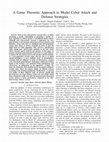
2018 IEEE International Conference on Communications (ICC), 2018
Most of the cybersecurity research focus on either presenting a specific vulnerability or proposi... more Most of the cybersecurity research focus on either presenting a specific vulnerability or proposing a specific defense algorithm to defend against a well-defined attack scheme. Although such cybersecurity research is important, few have paid attention to the dynamic interactions between attackers and defenders, where both sides are intelligent and will dynamically change their attack or defense strategies in order to gain the upper hand over their opponents. This 'cyberwar' phenomenon exists among most cybersecurity incidents in the real world, which warrants special research and analysis. In this paper, we propose a dynamic game theoretic framework (i.e., hyper defense) to analyze the interactions between the attacker and the defender as a non-cooperative security game. The key idea is to model attackers/defenders to have multiple levels of attack/defense strategies that are different in terms of effectiveness, strategy costs, and attack gains/damages. Each player adjusts his strategy based on the strategy's cost, potential attack gain/damage, and effectiveness in anticipating of the opponent's strategy. We study the achievable Nash equilibrium for the attacker-defender security game where the players employ an efficient strategy according to the obtained equilibrium. Furthermore, we present case studies of three different types of network attacks and put forth how our hyper defense system can successfully model them. Simulation results show that the proposed game theoretical system achieves a better performance compared to two other fixed-strategy defense systems.
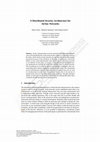
Secure communication in ad hoc networks is an inherent problem because of the distributiveness of... more Secure communication in ad hoc networks is an inherent problem because of the distributiveness of the nodes and the reliance on cooperation between the nodes. All the nodes in such networks rely and trust other nodes for forwarding packets because of their limitation in the range of transmission. Due to the absence of any central administrative node, verification of authenticity of nodes is very difficult. In this paper, we propose a clusterhead-based distributed security mechanism for securing the routes and communication in ad hoc networks. The clusterheads act as certificate agencies and distribute certificates to the communicating nodes, thereby making the communication secure. The clusterheads execute administrative functions and hold shares of network keys that are used for communication by the nodes in respective clusters. Due to the process of authentication, there are signalling and message overheads. Through simulation studies, we show how the presence of clusterheads can ...

In a distributed wireless system, such as an ad hoc network, multiple nodes behave cooperatively ... more In a distributed wireless system, such as an ad hoc network, multiple nodes behave cooperatively towards a common goal. For doing so, they make decisions independently and cooperatively such that they benefit the mission of the network. Though such assumptions on cooperation are desirable (e.g., controlling the transmit power level, reducing interference for each other, revealing private information, adhering to network policies) for analyzing and modeling, certain nodes belonging to a real-world system have often shown to deviate. These nodes, known as misbehaving nodes, bring more challenges to the design of the wireless network because the unreliable channel makes the actions of the nodes hidden from each other. In this project, we analyze misbehavior in wireless networks that have dire consequences on the performance of the network. In particular, we analyze two types of misbehavior, namely, selfish noncooperation and malicious attacking. We apply game theoretic techniques to model the interactions among the nodes in the network. First, we consider a homogeneous unreliable channel and analyze the necessary and sufficient conditions to enforce cooperative packet forwarding among a node pair. We formulate an anti-collusion game and derive the conditions that achieve full cooperation when the non-cooperative nodes collude. In addition, we consider multi-hop communication with a heterogeneous channel model. We refine our game model as a hidden action game with imperfect private monitoring. A state machine based strategy is proposed to reach Nash Equilibrium. The strategy attains cooperative packet forwarding with heterogeneous channel and requires only partial and imperfect information. Furthermore, it also enforces cooperation in multi-hop packet forwarding. To tackle the malicious attacks, we use Bayesian game analysis to show the existence of equilibrium in the detection game and argue that it might not be profitable to isolate the malicious nodes upon detection. We propose the concept of "coexistence with malicious nodes" by proving the coexistence equilibrium and derive the conditions that achieve the equilibrium. To validate and test the proposed theoretical models, we conduct extensive simulation studies. Simulation results illustrate the properties of the games and the derived equilibria. The results validate our design philosophy and clearly indicate that the proposed game theoretic solutions can be effectively used to enforce cooperation and mitigate attacks.
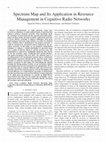
IEEE Transactions on Cognitive Communications and Networking, 2015
Measurements on radio spectrum usage have revealed an abundance of under-utilized bands of spectr... more Measurements on radio spectrum usage have revealed an abundance of under-utilized bands of spectrum that belong to primary (licensed) networks. Prior knowledge about the occupancy of such bands and the expected achievable performance on those bands can help secondary (unlicensed) networks to devise effective strategies to improve utilization. Such prior spatio-temporal spectrum usage statistics can either be obtained from a database that is maintained by the primary networks or could be measured by customized sensors deployed by the secondary networks. In this paper, we use Shepard's interpolation technique to estimate a spatial distribution of spectrum usage over a region of interest, which we call the spectrum map. The interpolation is achieved by intelligently fusing the data shared by the the secondary nodes considering their mutual distances and spatial orientation with each other. The obtained map is a two-dimensional (2-D) interpolation function that is continuously differentiable and passes through all the spectrum usage values recorded at arbitrary locations; thus providing a reference for primary occupancy in that region. For determining the optimal locations for sensing primary activity, we use an iterative clustering technique that uses tree structured vector quantization. We use the spectrum map to estimate different radio and network performance metrics like channel capacity, network throughput, and spectral efficiency. As a comprehensive case study, we demonstrate how the spectrum map can be used for efficient resource allocation in TV white space. In particular, we consider an IEEE 802.22based WRAN and show how the rendezvous probability can be improved for better radio resource allocation, thereby increasing the secondary spectrum utilization.
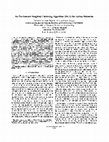
Globecom '00 - IEEE. Global Telecommunications Conference. Conference Record (Cat. No.00CH37137)
We consider a multi-cluster, multi-hop packet radio network architecture for wireless systems whi... more We consider a multi-cluster, multi-hop packet radio network architecture for wireless systems which can dynamically adapt itself with the changing network configurations. Due to the dynamic nature of the mobile nodes, their association and dissociation to and from clusters perturb the stability of the system, and hence a reconfiguration of the system is unavoidable. At the same time it is vital to keep the topology stable as long as possible. The clusterheads, which form a dominant set in the network, decide the topology and are responsible for its stability. In this paper, we propose a weighted clustering algorithm (WCA) which takes into consideration the ideal degree, transmission power, mobility and battery power of a mobile node. We try to keep the number of nodes in a cluster around a pre-defined threshold to facilitate the optimal operation of the medium access control (MAC) protocol. Our clusterhead election procedure is not periodic as in earlier research, hut adapts based on the dynamism of the nodes. This on-demand execution of WCA aims to maintain the stability of the network, thus lowering the computation and communication costs associated with it. Simulation experiments are conducted to evaluate the performance of WCA in terms of the number of clusterheads, reaflliation frequency and dominant set updates. Results show that the WCA performs better than the existing algorithms and is also tunable to different types of ad hoc networks.

2007 IEEE International Symposium on a World of Wireless, Mobile and Multimedia Networks, 2007
In this paper, we focus on the problem of routing in resource rationed ad hoc networks. We exempl... more In this paper, we focus on the problem of routing in resource rationed ad hoc networks. We exemplify the concept of resource rationing in a military scenario where the allocated resources are rationed to prolong the mission. By modeling the network as a directed weighted graph, we propose an economic approach to address the routing issue, namely HR 3. Our approach begins with a hierarchical bidding process, through which nodes in the network bid for virtual currency. The winning bids use the granted virtual currency to pay the intermediate nodes for packet forwarding. After successful delivery, nodes get rewards. We study the truthfulness of HR 3 with rational nodes and propose security extension to identify and isolate the malicious nodes. Through simulations on ns-2, HR 3 shows performance gains in data throughput and energy consumption.
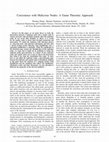
2009 International Conference on Game Theory for Networks, 2009
In this paper, we use game theory to study the interactions between a malicious node and a regula... more In this paper, we use game theory to study the interactions between a malicious node and a regular node in wireless networks with unreliable channels. Since the malicious nodes do not reveal their identities to others, it is crucial for the regular nodes to detect them through monitoring and observation. We model the malicious node detection process as a Bayesian game with imperfect information and show that a mixed strategy perfect Bayesian Nash Equilibrium (also a sequential equilibrium) is attainable. While the equilibrium in the detection game ensures the identification of the malicious nodes, we argue that it might not be profitable to isolate the malicious nodes upon detection. As a matter of fact, malicious nodes and regular nodes can co-exist as long as the destruction they bring is less than the contribution they make. To show how we can utilize the malicious nodes, a post-detection game between the malicious and regular nodes is formalized. Solution to this game shows the existence of a subgame perfect Nash Equilibrium and the conditions that achieve the equilibrium. Simulation results and their discussions are also provided to illustrate the properties of the derived equilibria.
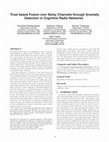
Proceedings of the 4th international conference on Security of information and networks, 2011
Byzantine attacks have been identified as one of the key vulnerabilities in cognitive radio netwo... more Byzantine attacks have been identified as one of the key vulnerabilities in cognitive radio networks, where malicious nodes advertise false spectrum occupancy data in a cooperative environment. In such cases, the resultant fused data is very different from the actual scenario. Thus, there is a need to identify the malicious nodes or at least find the trustworthiness of nodes such that the data sent by malicious nodes could be filtered out. The process is complicated by presence of noise in the channel which makes it harder to distinguish anomalies caused by malicious activity and those caused due to unreliable noisy channels. This paper proposes a scheme for trust based fusion by monitoring anomalies in spectrum usage reports advertised over unreliable channels by secondary nodes which leads to evaluation of trust of a node by its neighbors. The calculated trust is then used to determine if a neighboring node's advertised data could be used for fusion or not. We provide a heuristic trust threshold for nodes to disregard malicious nodes while fusing the data, which holds good for any probability of attack. A trust coefficient is calculated based on interactions with peers in a distributed manner. Results show that even at higher probabilities of attack (0.8 and above), 95% of the nodes generate fused data with accuracy as high as 84%. We compare our results of trust based fusion with blind fusion scheme and observe improvement in accuracy of fusion from individual nodes' as well as overall network's perspective. We also analyze an alternative weighted trust fusion technique and evaluate its performance. We find that at lower probabilities of attack a malicious node's contri

Lecture Notes in Computer Science, 2000
In this paper, we propose a distributed clustering algorithm for a multi-hop packet radio network... more In this paper, we propose a distributed clustering algorithm for a multi-hop packet radio network. These types of networks, also known as ad hoc networks, are dynamic in nature due to the mobility of the nodes. The association and dissociation of nodes to and from clusters perturb the stability of the network topology, and hence a reconfiguration of the system is often unavoidable. However, it is vital to keep the topology stable as long as possible. The clusterheads, which form a dominant set in the network, determine the topology and its stability. Our weight based distributed clustering algorithm takes into consideration the ideal degree, transmission power, mobility and battery power of a mobile node. We try to keep the number of nodes in a cluster around a pre-defined threshold to facilitate the optimal operation of the medium access control (MAC) protocol. The non-periodic procedure for clusterhead election gradually improves the load balance factor (LBF) which is a measure of the load distribution among the clusterheads. For lowering the computation and communication costs, the clustering algorithm is invoked on-demand which aims to maintain the connectivity of the network at the cost of load imbalance. Simulation experiments are conducted to evaluate the performance of our algorithm in terms of the number of clusterheads, reaffiliation frequency and dominant set updates. Results show that the our algorithm performs better than the existing algorithms and is also tunable to different types of ad hoc networks.

Wireless Networks, 2015
In this paper, we characterize the QoS that secondary users can expect in a cognitive radio netwo... more In this paper, we characterize the QoS that secondary users can expect in a cognitive radio network in the presence of primaries. To that end, we first define a Kdimensional QoS space where each point in that space characterizes the expected QoS. We show how the operating condition of the system maps to a point in the QoS space, the quality of which is given by the corresponding QoS index. To deal with the real-valued QoS space, we use vector quantization to partition the space into finite number of regions each of which is represented by one QoS index. We argue that any operating condition of the system can be mapped to one of the pre-computed QoS indices using a simple look-up in Oðlog NÞ time-thus avoiding any cumbersome computation for QoS evaluation. The proposed technique takes the power vector as its input from the power control unit which we consider as a black box. Using simulations, we illustrate how a K-dimensional QoS space can be constructed. We choose capacity as the QoS metrics and show what the expected capacity would be for a given power vector. We also show the effect of having large number of partitions on the distortion. As for the implementation feasibility of the proposed concept, we implement the QoS space on an 8-bit microcontroller and show how the mathematically intensive operations can be computed in a short time. Further we use binary search to achieve scalability as the dimensionality of the space increases.

2013 IEEE Global Communications Conference (GLOBECOM), 2013
Design of an efficient medium access control protocol is critical for proper functioning of a dis... more Design of an efficient medium access control protocol is critical for proper functioning of a distributed cognitive radio network and better utilization of the channels not being used by primary users. In this paper, we design a contention based distributed medium access control (MAC) protocol for the secondary users' channel access. The proposed MAC protocol allows collision-free access to the available data channels and eventually their utilization by secondary users, with spectrum sensing part being handled by exclusive sensing nodes. We further introduce the provision of reservation of free channels by secondaries for extended periods to increase utilization without causing harmful interference to primaries. We demonstrate how such extended access to resources can be tuned to provide differential quality of service to the secondary users. The effectiveness of the protocol is evaluated by performing analysis and simulation. We use blocking probability, secondary usage of a secondary user and performance degradation caused to primary incumbents as performance metrics. We obtain the conditions for such extended access and try to gauge the resulting increase in utilization. Under optimal conditions, the proposed scheme enables the secondary network to utilize all available channels. The proposed scheme is shown to outperform the most sophisticated existing MAC schemes for distributed secondary networks.
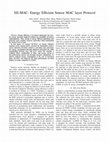
38th Annual IEEE Conference on Local Computer Networks - Workshops, 2013
Energy efficiency is of utmost importance for wireless sensor networks deployed without any possi... more Energy efficiency is of utmost importance for wireless sensor networks deployed without any possibility of battery replenishments. Thus, design of energy efficient algorithms and protocols must consider resource constraints while maintaining the desired level of QoS. In this paper, we present EE-MAC, an Energy Efficient medium access control (MAC) protocol for distributed wireless sensor networks. EE-MAC achieves a low-duty-cycle and hence low energy consumption through optimized sleep intervals while transitioning between sleep and active states. We consider a weighted linear combination of delay and energy saving as the performance metrics and through extensive simulations, we observe reduced energy consumption at the cost of increased delay. EE-MAC also improves the delay performance for fixed number of nodes compared to S-MAC.
Lecture Notes in Computer Science, 2008
event started off nine years ago as a small workshop for distributed computing researchers in Ind... more event started off nine years ago as a small workshop for distributed computing researchers in India, and has gradually matured into a true international conference, while simultaneously widening its scope to cover most aspects of distributed computing and networking. We received 185 submissions from all over the world, including Australia,

Wireless Networks, 2005
Optimal power control is of great importance for CDMA systems and it can be controlled to provide... more Optimal power control is of great importance for CDMA systems and it can be controlled to provide the desired quality of service (QoS) to mobile hosts in a cellular radio system. The power levels of all the mobile hosts are determined and constantly tuned in order to achieve the required SINR (signal to interference and noise ratio) which changes dynamically. The SINR of all the K mobiles in a cell can be expressed in the form of a k-dimensional vector. It helps determine the operating point of the system and hence it is constantly monitored and updated due to the variability in the wireless channel conditions and user mobility. We view this continuously changing vector as the motion of a point in a higher dimensional Euclidean space, called the QoS space. We apply vector quantization technique to shrink the infinite-point space to a finite-point space by partitioning the former into N regions such that the points within a region reflect almost similar system performance and are identified by what we call a QoS index. We show how the system operating point can be mapped to one of the QoS indices. The location of the point or the region of operability in the QoS space conveys the system status in terms of the current load and the QoS being delivered. The dynamism in the system's input conditions due to wireless link characteristics and user mobility acts like an opposing force against which the system has to operate. The system reacts to all such changes preventing it from going into a region with an undesirable QoS index. We show how the apriori knowledge of the operating region helps in decision making pertaining to call admission and resource allocation in CDMA systems.
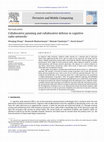
Pervasive and Mobile Computing, 2013
In cognitive radio networks, cognitive nodes operate on a common pool of spectrum where they oppo... more In cognitive radio networks, cognitive nodes operate on a common pool of spectrum where they opportunistically access and use parts of the spectrum not being used by others. Though cooperation among nodes is desirable for efficient network operations and performance, there might be some malicious nodes whose objective could be to hinder communications and disrupt network operations. The absence of a central authority or any policy enforcement mechanism makes these kinds of open-access network more vulnerable and susceptible to attacks. In this paper, we analyze a common form of denial-of-service attack, i.e., collaborative jamming. We consider a network in which a group of jammers tries to jam the channels being used by legitimate users who in turn try to evade the jammed channels. First, we compute the distribution of the jamming signal that a node experiences by considering a random deployment of jammers. Then, we propose different jamming and defending schemes that are employed by the jammers and legitimate users, respectively. In particular, we model and analyze the channel availability when the legitimate users randomly choose available channels and the jammers jam different channels randomly. We propose a multitier proxy-based cooperative defense strategy to exploit the temporal and spatial diversity for the legitimate secondary users in an infrastructure-based centralized cognitive radio network. Illustrative results on spectrum availability rates show how to improve resiliency in cognitive radio networks in the presence of jammers.
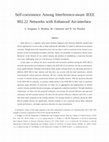
Pervasive and Mobile Computing, 2013
IEEE 802.22 is a cognitive radio based Wireless Regional Area Network (WRAN) standard that allows... more IEEE 802.22 is a cognitive radio based Wireless Regional Area Network (WRAN) standard that allows opportunistic access to idle or under-utilized sub-900 MHz TV bands by unlicensed (secondary) networks. Though most of the standard has been laid out, there is still no consensus on the channel access policies for the uncoordinated secondary networks. Hence, the possibility of interference always exists. Moreover, in the absence of any control channel, the problem of establishing a connection becomes even more challenging, more so in the presence of hidden incumbents. In this paper, we address the above mentioned self-coexistence problem among the IEEE 802.22 networks and provide novel solutions to improve the IEEE 802.22 air-interface. We use an interferenceaware graph theoretic technique and propose utility graph coloring (UGC) for allocating spectrum to different IEEE 802.22 base stations such that they can co-exist with the least interference, thereby maximizing the system spectrum utilization. We also consider allocation fairness among the networks in terms of minimal fairness, proportional fairness, and complete fairness. With the spectrum allocated to the IEEE 802.22 networks, we propose enhancements to the IEEE 802.22 MAC layer to maximize spectrum usage efficiency. In particular, we make use of aggregation and fragmentation of channel carriers, dynamic multiple broadcast messages, and aggressive contention resolution. Through simulation experiments, we show how the proposed techniques can increase the spectral efficiency and spectrum utilization, and still maintain fairness. We show that the spectral efficiency obtained with UGC is more than three times compared to the existing standard. The average number of collisions among the IEEE 802.22 enabled devices are significantly reduced resulting in low connection setup delay, enhanced system performance, and higher spectrum allocation for data transmissions.
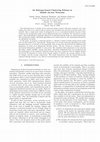
Journal of Ubiquitous Computing and Intelligence, 2007
The distributiveness of mobile ad hoc networks makes resource allocation strategies very challeng... more The distributiveness of mobile ad hoc networks makes resource allocation strategies very challenging since there is no central node to monitor and coordinate the activities of all the nodes in the network. Since a single node cannot be delegated to act as a centralized authority because of limitations in the transmission range, several delegated nodes may coordinate the activities in certain zones. This methodology is generally referred to as clustering and the nodes are called clusterheads. The clusterheads employ centralized algorithms in its cluster; however, the clusterheads themselves are distributive in nature. In this paper, we propose a clustering scheme i.e., identify a subset of nodes among all the nodes that are best suited to be clusterheads. Though there are several clustering algorithms previously proposed; however, to the best of our knowledge, there is none that characterizes the different node parameters in terms of an information theoretic metric. We use entropy as a measure of local and mutual information available to every node. We considered three parameters in the selection procedure, namely, mobility, energy, and degree. Extensive simulations have been conducted and the performance of the proposed clustering scheme has been compared with the Highest Degree and Lowest ID heuristics in terms of the average number of clusters, the average number of cluster changes, and the average connectivity. The results demonstrate that the mutual information captured through entropy is very effective in determining the most suitable clusterheads.
IEEE Transactions on Vehicular Technology, 2009











Uploads
Papers by Mainak Chatterjee